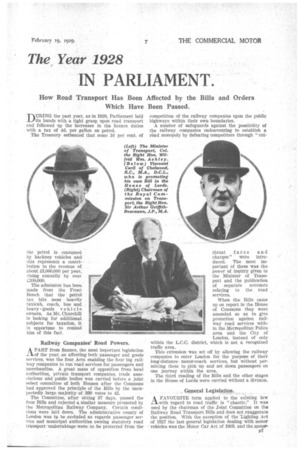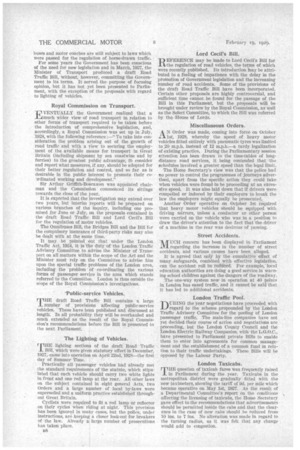• The Year 1928
Page 97

Page 98

If you've noticed an error in this article please click here to report it so we can fix it.
IN PARLIAMENT.
How Road Transport Has Been Affected by the Bills and Orders Which Have Been Passed.
DURING the past year, as in 1926, Parliament laid _Lifts hands with a tight grasp upon road transport and followed up the increases in the licence duties with a tax of 4d, per gallon on petrol.
The Treasury estimated that some 16 per cent. of the petrol is consamed. by hackney vehicles and this represents a contribution to the revenue of about i3,000,000 per year; :rising annually by over £200,000.
The admission has been made from the Front Bench that the petrol tax hits. most heavily taxicab, coach, bus and heavy -:goods vehicle owners, As Mr. Churchill is looking for additional subjects for taxation, it is opportune to remind him of this fact, Railway Companies! Road Powers.
A PART from finance, the most important legislation of the year, as affecting bothpassenger and goods services, was the four Acts enabling the four big railway companies to run road services for passengers and merchandise, A great mass of opposition from local authorities, private transport companies, trade associations and public bodies was carried before a joint select committee of both Houses after the Commons had approved the principle. of the Bills by the unexpectedly large: majority of 399 votes to 42. . The Committee, after sitting 37 days, passed the four Bills and rejected a similar measure promoted. by the Metropolitan Railway Company; Certain conditions were laid down. The administrative county of London was to be excluded as regards passenger service and municipal authorities owning statutory road tt;ansport .untiertakings,were: to. be protected 'from the competition of the railway companies upon the public highways within their own boundaries.
A number of safeguards against the possibility of the railway companies endeavouring to establish a road monopoly by defeating competitors through " cut throat fares and charges" were introduced. The most important of these was the powerof inquiry given to the Minister of Transport and the publication of separate accounts relating to the . road services.
When the Bills came up on report in the House of Commons they were amended so as to give protection against railway road services within the Metropolitan Police area and the City of London, instead of only within the L.C.C. district, which is not a recognized traffic area.
This extension was set off by allowing the railway companies to enter London for the purpose of their long-distance, motor-coach services, but without permitting them to pick up and set down passengers on one journey within the area.
The third reading of the Bills and the other stages in the House of Lords were carried without a division.
. General Legislation.
A FAVOURITE term applied to the existing law -L-1.with regard to road traffic is "chaotic.' It was used by the chairman of the Joint Committee on the Railway Road Transport Bills and does not exaggerate the position. With the excePtion of the 'Lighting Act of 1927 the last general legislation dealing with motor vehicles was the Motor Car Act of 1903. and theanotor
buses and motor coaches are still subject to laws which were passed for the regulation of horse-drawn traffic.
For some years the Government has been conscious of the need for new legislation and in March, 1927, the Minister of Transport produced a draft Road Traffic Bill, without, however, committing the Govern• ment to its terms. It served the purpose of focusing opinion, but it has not _yet been presented to Parliament, with the exception of the proposals with regard to lighting of vehicles.
Royal Commission on Transport. 'LlVENTUALLY the Government realized that a
A
much wider view of road transport in relation to other forms of transport required to be taken before the introduction of comprehensive legislation, and, accordingly, a Royal Commission was set up in July, 1928, with the following reference:—' To take into con:. sideration the problem arising out of the growth of road traffic and with a view to securing the employment of the available means for transport in Great Britain (including shipment by sea coastwise and by ferries) to the greatest public advantage, ro consider and report what measures, if any, should be adopted for their better regulation and control, and so far as is desirable in the publie interest to promote their co7rdinated working and development."
Sir Arthur Griffith-Boscawen was appointed chairman and the Commission commenced its sittings towards the close of the year.
It is expected that the investigation May extend over two years, but interim reports will be prepared on various branches of the inquiry, including one promised for June or July, on the proposals contained in the draft Road Traffic Bill and Lord Cecil's Bill for the regulation of motor vehicles.
The Omnibuses Bill, the Bridges Bill and the Bill for the compulsory insurance of third-party risks may also be dealt with at the same time.
It may be pointed out that under the London Traffic Act, 1924, it is the duty of the London Traffic Advisory Committee to advise the Minister of Transport on all matters within the scope of the Act and the Minister must rely on the Committee to advise him upon the special traffic problems of the London area, including the problem " of co-ordinating the various forms of passenger service in the area which stands referred to the Committee. London is thus outside the scope of the Royal Commission's investigations.
Public-service Vehicles.
MIIE draft Road Traffic Bill contains a large number of provisions affecting public-service vehicles. These have been published and discussed at length". In all probability they will be overhauled and much extended as the result of the Royal Commission's recommendations before the Bill is presented to the next Parliament.
The Lighting of Vehicles.
rpHE lighting sections of the draft Road Traffic _L Bill, which were given statutory effect in December, 1927, came into operation on April 22nd, 1928—the first day of Summer Time.
Practically all passenger vehicles had already met the standard requirements of the statute, which stipulated that each vehicle should carry two white lights in front and one red lamp at the rear. All other laws on the subject contained in eight general Acts, two Orders and a large number of local by-laws were superseded and a uniform practice established throughout Great Britain.
Cyclists were required to fit a red lamp or reflector on their cycles when riding at night. This provision has been ignored in many cases, but the police, under instructions, are keeping a closer look-out for breakers Of the law. Already a large namber of prosecutions has taken place.
. D8 February 19, 1929. Lord Cecil's Bill.
EFERENCE may be made to Lord Cecil's Bill for lithe regulation of road vehicles, the terms of which were recently published. Its introduction may be attributed to a feeling of impatience with the delay in the promotion of Government legislation and the increasing number of road accidents. Some of the provisions of the draft Road Traffic Bill have been incorporated. Certain other proposals are highly controversial, and sufficient time cannot be found for the passage of the Bill in this • Parliament, but the proposals will be brought under review by the Royal Commission, as well as the Select Committee, to which the Bill was referred by the House of Lords.
Miscellaneous Orders.
A N Order was made, coming into force on October
1st, 1928, whereby the speed of heavy motor vehicles fitted entirely with pneumatic tyres was limited to ,20 m.p.h. instead of 12 m.p.h.—a tardy legalization of existing practice. During the Parliamentary session attention has been drawn to the time-tables of longdistance road services, it being contended that the schedules involved a greater speed than the legal limit. The Home Secretary's view was that the police had no power to control the programmes of journeys advertised, apart from the specific action they could take when vehicles were found to be proceeding at an excessive speed. It was also laid down that if drivers were compelled or induced by their employers to break the law the employers might equally he prosecuted.
Another Order operative on October 1st required that heavy motor vehicles should be equipped with driving mirrors, unless a conductor or other person were carried on the vehicle who was in a position to draw the driver's attention to the fact that the driver of a machine in the rear was desirous of passing.
Street Accidents.
MUCH concern has been displayed in Parliament regarding the increase in the number of street accidents, and various causes have been alleged.
It is -agreed that only by the cumulative effect of many Safeguards, combined with effective legislation, can the accident roll be reduced. For example, "local education authorities are doing a good service in warning school children against the dangers of the roadway. The one-way system now in operation at 40 points in London has eased traffic, and it cannot be said that it has led to additional accidents.
London Traffic Pool.
TURING the Year negotiations have proceeded with _Liregard to the scheme propounded by the London Traffic Advisory Committee for the pooling of London passenger traffic. The main-line companies have not yet decided their course of action and negotiations are proceeding, but the London County Council and the London Electric Railway Companies, with the L.G.O.C., have presented to Parliament private Bills to enable• them to enter into agreements for common management and the establishment of a common fund in relation to their traffic undertakings, These Bills will he opposed by the Labour Party.
London Taxicabs.
THE question of taxicab fares was frequently raised in Parliament during the year. Taxicab's in the metropolitan district were gradually fitted with the new taximeters, showing the tariff of .9d. per mile which became operative on May 1st, 1927. AS the result of a Departmental Committee's report on the conditions affecting the licensing of taxicabs, the Home Secretary gave effect to the recommendations that advertisements. should be permitted inside the cabs and that the clearance in the case of new cabs should be reduced from 10 ins. to 7 ins. No alteration was made in regard to the turning radius, as it was felt that any change would add to congestion.




























































































































































































































